|


by
Pierre Stromberg and Paul V. Heinrich
Last Updated: April 18, 2005
from
TalkOrigins Website
|
While mineral hunting in
the mountains of California near Olancha during the
winter of 1961, Wallace Lane, Virginia Maxey
and Mike Mikesell found a rock, among many
others, that they thought was a geode - a good addition
for their gem shop. Upon cutting it open, however,
Mikesell found an object inside that seemed to be
made of white porcelain. In the center was a shaft of
shiny metal.
Experts estimated that, if
this was a geode, it should have taken about
500,000 years for this fossil-encrusted nodule to
form, yet the object inside was obviously of
sophisticated human manufacture. Further investigation
revealed that the porcelain was surround by a hexagonal
casing, and an x-ray revealed a tiny spring at one end,
like a spark plug. Thereís a bit of controversy around
this artifact, as you can imagine. Some contend that the
artifact was not inside a geode at all, but encased in
hardened clay.
The artifact itself has
been identified by experts as a 1920s-era Champion
spark plug. Unfortunately, the Coso Artifact
has gone missing and cannot be thoroughly examined. Is
there a natural explanation for it? Or was it found, as
the discoverer claimed, inside a geode? If so, how could
a 1920s sparkplug get inside a 500,000-year-old rock?
|
Introduction
Creationists have often been criticized for failing to present
original research and evidence that would overthrow our contemporary
view of human origins in favor of another. However, this is not an
entirely fair accusation. The creation "science" field known as
OOPARTS, or "Out Of Place ARTifactS" is a lively area of study with
numerous examples that relies on "anomalous" finds in the
archaeological record to challenge scientific chronologies and
models of human evolution. This paper will examine the most popular
and least understood specimen, the Coso Artifact.
The Discovery
The story of the Coso Artifact has been embellished over the years,
but nearly all accounts of the actual discovery are basically the
same.
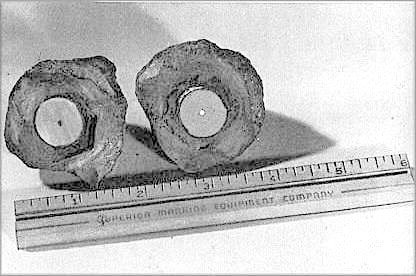
Figure 1
The original artifact sliced in two
On February 13, 1961, Wallace Lane, Virginia Maxey, and
Mike Mikesell were seeking interesting mineral specimens, particularly
geodes, for their "LM & V Rockhounds Gem and Gift Shop" in Olancha,
California. On this particular day, the trio was about six miles
northeast of Olancha, near the top of a peak about 4300 feet in
elevation and about 340 feet above the dry bed of Owens Lake.
According to Maxey,
"We hiked about three miles north, after we had
parked some five miles east of State Highway 395, south of Olancha,
California."
At lunchtime, after collecting rocks most of the
morning, all three placed their specimens in the rock sack Mikesell
was carrying.
The next day in the gift shopís workroom, Mikesell ruined a nearly
new diamond saw blade while cutting what he thought was a geode.
Inside the nodule that was cut, Mikesell did not find the cavity
that is typical of geodes, but a perfectly circular section of very
hard, white material that appeared to be porcelain. In the center of
the porcelain cylinder, was a 2-millimeter shaft of bright metal.
The metal shaft responded to a magnet.
There were still other odd qualities about the specimen. The outer
layer of the specimen was encrusted with fossil shells and their
fragments. In addition to shells, the discoverers noticed two
nonmagnetic metallic metal objects in the crust, resembling a nail
and a washer. Stranger still, the inner layer was hexagonal and
seemed to form a casing around the hard porcelain cylinder. Within
the inner layer, a layer of decomposing copper surrounded the
porcelain cylinder.
The Initial
Investigations
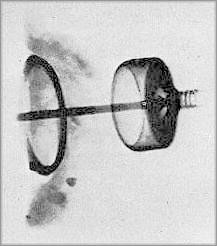
Figure 2
X-ray of the Coso artifact.
Very little is known about the initial physical inspections of the
artifact. According to discoverer Virginia Maxey, a geologist she
spoke with who had examined the fossil shells encrusting the
specimen said the nodule had taken at least 500,000 years to attain
its present form. However, the identity of the first geologist is
still a mystery, and his findings were never officially published.
Another investigation was conducted by creationist Ron Calais.
Calais is the only other individual known to have physically
inspected the artifact, and was allowed to take photographs of the
nodule in both X ray and natural light. Calaisí X-rays brought
interest in the artifact to a new level. The X-ray of the upper end
of the object seemed to reveal some sort of tiny spring or helix.
INFO Journal Publisher Ronald J. Willis speculated that it could
actually be "the remains of a corroded piece of metal with threads."
The other half of the artifact revealed a sheath of metal,
presumably copper, covering the porcelain cylinder.
The
Artifact: Where Is It Now?
The last known individual to possess the Coso Artifact was one of
the original discoverers, Wallace Lane. According to the Spring 1969
issue of INFO Journal, Lane was the last known person to possess the
object. It was on display in his home, but he adamantly refused to
allow anyone to examine it. However, he had a standing offer to sell
it for $25,000. In September 1999, a national search to locate any
of the original discoverers proved fruitless, The authors of this
article suspect that Lane had died. Virginia Maxey is alive, but is
avoiding any public comment and the whereabouts of Mikesell remain
unknown. The location and disposition of the artifact are also
unknown.
Fantastic Speculations
Ever since the artifact was first discovered, numerous individuals
have speculated about its mysterious origin and possible use.
Maxey speculated that,
"one possibility is that it is barely 100
years old - something that lay in a mud bed, then got baked and
hardened by the sun in a matter of a few years."
However it was
Maxey who supplied the claim that the artifact could be at least
500,000 years old.
"Or else it is an instrument as old as legendary
Mu or
Atlantis. Perhaps it is a communications device or some sort
of directional finder or some instrument made to utilize power
principles we know nothing about."
INFO Journal editor Paul J. Willis speculated that the artifact was
some sort of spark plug. His brother found the suggestion
extraordinary.
"I was thunderstruck," he wrote, "for suddenly all
the parts seemed to fit. The object sliced in two shows a hexagonal
part, a porcelain or ceramic insulator with a central metallic shaft
- the basic components of any spark plug."
However, the two could
not reconcile the upper end featuring a "spring", "helix", or "metal
threads" with any contemporary spark plug. So the mystery continued.
The artifact even appeared briefly at the end of an "In Search
Of..." episode hosted by Leonard Nimoy.
The Internet offers a plethora of other opinions on the subject.
While most websites simply report the mystery as described earlier,
some have taken to speculate on the purpose and origin of such a
device. Brian Wood, described as,
"International Director of MICAP
(Multinational Investigations Cooperative on Aerial Phenomena) and
Producer/Director of The Paranet Continuum Radio Program" suggested
that if it isnít simply a spark plug, "My guess would be some sort
of antenna. The construction reminds me of modern attempts at
superconductors. Wonder if anyoneís tried replicating the thing
using ceramic superconductors and then cooling the thing off with
liquid nitrogen to see what happens."
Joe Heldís "Joeís UFOs and Space Mysteries" thinks the device,
"looks
similar to a small capacitor with several different materials. The
object is roughly the size of an auto spark plug. Since the
formation of geodes can take millions of years this was a very
curious find indeed." (Source:
http://members.tripod.com/J_Kidd/index.html).
The
Creationists and the Artifact
With such outrageous speculation, individuals familiar with the
creation/evolution controversy would assume that fundamentalist
Christians would stay far away from such artifacts and stories. But
this is far from the case. Numerous creationists have been involved
with this artifact since its discovery.
Ron Calais, who was involved with the Coso Artifact since its
initial discovery, is an active contributor to creationist
literature (see, for example, "Slippery Phylogenies: Evolutionary
Speculations on the Origin of Frogs", Calais and Mehlert 1996). He
brought the Coso Artifact to the attention of the Charles Fort
Society, publisher of INFO Journal. Willisí 1969 article is the
primary source for information on this object to date.
Creation Outreach, a Spokane, Washington based creationism ministry
promotes the artifact on its website (source:
http//home.att.net/~creationoutreach/pages/strange.htm
September 22, 1999) by reprinting an article by J.R. Jochmans. Jochmansí article on the
Creation Outreachís website, originally available through the
national Bible-Science Association concluded,
"As a whole, the íCoso artifactí is now believed to be something
more than a piece of machinery: The carefully shaped ceramic,
metallic shaft and copper components hint at some form of electrical
instrument. The closest modern apparatus that researchers have been
able to equate it with is a spark plug. However, there are certain
features - particularly the spring or helix terminal - that does
[sic] not correspond to any known spark plug today."
It should also be noted that according to a letter printed in
"Atlantis Arising", J.R. Jochmans claims to have ghost-written three
quarters of the book "Secrets of the Lost Races" by
Rene Noorbergen.
"Secrets of the Lost Races" has often been cited as a reference for
the Coso Artifact by young-earth creationists.
For example, Carl Baugh, a young-earth creationist whose claim to
fame is the promotion of the Paluxy River Tracks, relies on
Noorbergen (1977) in his discussion of the Coso Artifact in his
online dissertation.
(source:
http://home.texoma.net/~linesden/cem/diss/diss2.htm
October 10, 1999)
Elsewhere in the Pacific Northwest, the Institute for Creation
Research- ICR has been heavily promoting the Coso Artifact through its
adjunct faculty member, Dr. Donald Chittick. According to his own
literature, Chittick, a Newberg, Oregon resident, holds a Ph.D. in
physical chemistry and has taught at the University of Puget Sound
and George Fox College. Dr. Chittick is also an active lecturer,
having traveled in the United State and Canada for the past 30
years, speaking before students both public and private about
creationism. In 1981, he was one of five "creation scientists" who
testified in pretrial depositions for the Arkansas "Balanced
Treatment Act", which required that "creation science" be taught
along with evolutionary biology in that stateís public schools. And
in 1993, his lecture to public high school students in Stanwood,
Washington led to a community furor, threats from the ACLU, and a
subsequent shakeup in the local school board.
Although he claims to have little to do with the ICR, Chittick
encourages audiences at his lectures to join the ICR, sells their
literature, and signs up interested parties for the its mailing
list. Chittick also delivered his "Puzzle of Ancient Man" lecture on
March 9, 1999, in Winnipeg, Manitoba. The event was sponsored by the
ICR as part of their "Case for Creation" lecture series. According
to the ICR, adjunct faculty members are,
"expected to be of high moral
character and personal integrity, firmly committed to the ICR
Tenets and Educational Philosophy."
"The Puzzle of Ancient Man" lecture is
basically a summary of
Chittickís book of the same title. In his
book (second edition), Chittick presents the Coso Artifact as
evidence that ancient civilizations were extremely advanced and in
some ways, more advanced than contemporary civilization. Presuming
that it is an ancient spark plug, Chittick explains,
"A spark plug is evidence of fairly
sophisticated development. Reliable dates for such finds are
difficult to obtain. However, it has been commonly assumed that
formation of geodes requires significant amounts of time.
Finding a spark plug in a rock considered to be very old would
indeed give it the label of an out-of-place artifact. Evidence
of advanced technology, like spark plugs, should not, according
to evolutionism, be discovered in old rocks."
Problems with the
Artifact Story
Creationist and other proponents of the artifact have woven a
riveting story. But a multitude of problems regarding the claims and
recent discoveries have cast a much different picture.
The Geologic Evidence: Is the Coso Artifact Encased in a Geode?
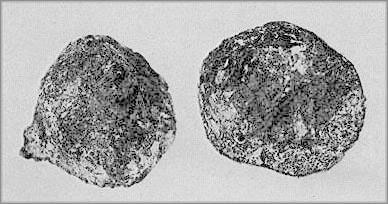
Figure 3
The outer casing surrounding the Coso Artifact.
When it comes to the geologic evidence, the most stunning claim is
that the artifact was discovered in a geode. As Donald Chittick has
noted, formation of a geode requires significant amounts of time.
But what is often overlooked is that the Coso Artifact possesses no
characteristics that would classify it as a geode. It is true that
the original discoverers were looking for geodes on the day the
artifact was found. But this alone is insufficient evidence that the
artifact is a geode.
Geodes consists of a thin outer shell, composed of dense chalcedonic
silica, and are filled with a layer of quartz crystals. The Coso
Artifact does not possess either feature. Discoverer Virginia Maxey
referred to the material covering the artifact as "hardened clay"
and noted that it had picked up a miscellaneous collection of
pebbles, including a "nail and washer." Analysis of the surface
material is noted as having a hardness of Mohs 3, which is not very
hard and certainly much softer than chalcedony.
Other arguments regarding the ancient source of the Coso Artifact
focus on the alleged fossil shells encrusted on the surface. If, as
noted earlier, a nail and washer were also found on the same surface
as the fossil shells, then the power of the inference of an ancient
age for the artifact is seriously diminished. Even creationist
literature notes how surface materials can lead to mistaken
assumptions about the true age of individual objects. For example,
Creation Ex Nihiloís June-August 1998 issue features fence wire that
had become encased by surface materials including "fossil" seashells
(quotes in the original article).
The
Artifact Itself: What Is It?
As noted earlier, numerous individuals have speculated about the
identity of the Coso Artifact. The most popular suggestion is that
it is some sort of spark plug, designed and manufactured by an
advanced civilization eons ago for technological devices equal to or
surpassing our own. But as mentioned earlier, thereís no reason to
assume that the artifact was manufactured thousands of years ago.
Some have half-heartedly suggested that the device could have been a
contemporary spark plug circa 1961. But ancient artifact proponents
point to the X-ray of the top half, which indicates some type of
tiny spring or helix mechanism. The content of this X-ray, they
argue, runs contrary to what we know about contemporary spark plugs.
A clue to what is revealed in the X-ray lies in one of the earliest
articles about the artifact. In the Spring 1969 issue of INFO
Journal, Ronald Willis suggested that the upper end of the object
"is actually the remains of a corroded piece of metal with threads."
The Willis brothers seriously suspected the object was a
contemporary spark plug, but were still unable to explain what was
in the X-ray. Spark plugs of the 1960ís era typically terminated
with no visible threading and tapered to a dull point.
Though many of the interested parties agreed that the artifact bore
a striking resemblance to a twentieth-century spark plug, no one
seems to have considered the idea of evolution - specifically, spark
plug evolution.
Investigating the origins of the Coso Artifact revealed that mining
operations were conducted in the area of discovery early in the 20th
century. If internal combustion engines were used in these
operations in the Coso mountain range, they would have been a very
new technology at the time. So, the authors of this article
extrapolated that spark plug technology would also have been in its
infancy. To help the authors of this article identify the Coso
Artifact, they decided to turn to a little-known group of experts -
The Spark Plug Collectors of America.
Letters were sent to four different spark plug collectors describing
the Coso Artifact, including Ron Calaisí X-rays of the object in
question. Collectors were asked if they could identify what they saw
in the photos. The collectors were expected to provide some vague
hints, or to not be able to identify the artifact at all. Their
actual answers were stunning.
On September 9, 1999, Chad Windham, President of the Spark Plug
Collectors of America called Pierre Stromberg of Pacific Northwest
Skeptics. Windham initially suspected that Stromberg was a fellow
spark plug collector, writing incognito, with the ostensible motive
of hoaxing him. His fears were compounded by the fact that there is
an actual line of spark plugs named "Stromberg." Windham had also
contacted another spark plug collector, strongly suspecting that he
was the culprit, and made a point of looking up the website of
Pacific Northwest Skeptics to ensure it actually existed.
Though Stromberg repeatedly assured Windham that his intentions were
purely for research, he was puzzled why Windham was so suspicious
and asked him to explain. Windham replied that it was so obvious to
him that the artifact was a contemporary spark plug, the letter had
to be a hoax. "I knew what it was the moment I saw the x-rays"
Windham stated. He also added that it was not uncommon at all for
spark plug collectors to play pranks on one another.
"Are you sure itís a spark plug?"
Stromberg asked?
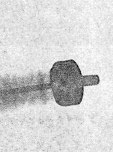
Figure 4
X-ray of a 1920s Champion spark plug provided by Chad Windham
"Thereís no question about it,"
Windham replied, barely containing his laughter, "itís a spark
plug."
Stromberg asked Windham if he could
identify the particular make of the spark plug. Windham replied he
was certain that it was a 1920ís era Champion spark plug. Stromberg
was stunned by the collectorís certainty, but Windham insisted that
he had nailed the identification. Windham offered to send two
identical spark plugs, the only possible but slight difference being
the diameter of the packing nut at the base of the plug. Stromberg
accepted Windhamís offer and a few days later a package arrived in
the mail.
Ten days after the phone call with Windham, Pierre Stromberg
received a phone call from Bill Bond, founder of the Spark Plug
Collectors of America, and curator of a private museum of spark
plugs containing more than two thousand specimens. Bond said he
hadnít spoken to Windham, but said he thought he knew the identity
of the Coso Artifact,
"A 1920s Champion spark plug."
Spark plug
collector Mike Healy also concurred with Bond and Windhamís
assessment about the spark plug. The fourth collector, Jeff Bartheld,
Vice-President of the Spark Plug Collectors of America contacted
Stromberg via postal mail on October 18, 1999, and also confirmed
that the artifact was a 1920s Champion spark plug. To date, there
has been no dissent in the spark plug collector community as to the
origins of the Coso Artifact.
Since Chad Windham mentioned that spark plug collectors enjoy
pulling pranks on one another, the question of deliberate fraud
inevitably crops up in relation to the Coso Artifact. However, there
is little hard evidence that the original discoverers intended to
deceive anyone from the start. Pacific Northwest Skeptics
investigated the Spark Plug Collectors of America. The group formed
in 1975, well after the discovery of the artifact, and none of the
three discoverers was ever affiliated in any way that the collectors
can recall. Windham and Bond insist that while spark plug collectors
enjoy hoaxing one another, they cannot imagine that any of their
members would take a prank this far.
Comparisons and Analysis
On September 14, 1999, Stromberg received a package from Chad
Windham. Inside the package were the two spark plugs Windham had
promised along with an analysis of the specimens. Windham writes:
I am enclosing two spark plugs made
by Champion Spark Plug company circa - 1920ís. Plug #1 is 7/8" -
18 thread. I have loosely assembled the plug, and chipped the
"brass hat" off to show the configuration of it and the
porcelain under it. Plug #2 is 1/2" NPT - of same design.
The diameter of the porcelain on Plug #1 is slightly less than
3/4" - close to the dimension in your letter. As you can see the
base and packing nut which hold the porcelain, are sealed with a
copper and asbestos gasket. This corresponds with the article.
The center electrode of plugs were made of special alloys which
may support "...cut in two in 1961 but five years afterwards had
no tarnishing visible."
The sketches included clearly show one rib on the upper end of
the porcelain, although Champion used two ribs in this era -
probably just an artistís error. The "top hat matches those of
"plug 1 and 2."
As for the outer shell, it obviously decayed - probably from
salt water (or other corrosive substance) and the outer crust is
merely some sort of deposit like sea shells or other deposits
collected on the deteriorating surfaces of the spark plug base.
There is NO doubt that this is merely an old spark plug. Most
probably, it is a Champion spark plug, similar to the two
enclosed.
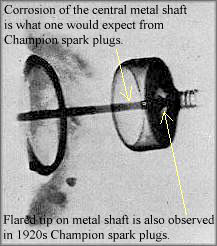
Figure 5
Analysis of the original Coso Artifact X-ray.
Windhamís letter did indeed match a careful analysis of the
specimens. Most striking is the brass "top hat" that has so vexed
previous attempts to provide a rational explanation for the
artifact. But the similarities are more than skin deep. Because
Windham had chipped the brass top hat off specimen #1, the spark
plug revealed a metal shaft terminating in a flared end, presumably
to help secure the top hat to the plugís porcelain cylinder. This
revelation led to speculation that such a flared tip could also be
visible in the original X-ray of the brass hat. And indeed, as shown
at left, the flared end of the metal shaft also appears in the Coso
Artifact.
The shaft in the X-ray, just below the
flare, also reveals deterioration until it meets the porcelain
cylinder. This, too, is exactly what we would expect if the artifact
is a 1920s-era Champion spark plug. An X ray of the authorsí own
disassembled specimen reveals a picture very similar to the original
X-ray of the Coso Artifact. As with the original artifact, the
central metal shaft of both specimens responds to a magnet.
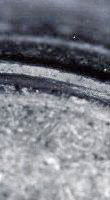
Figure 6
Copper ring from 1920s Champion spark plug.
Proponents of fantastic stories regarding the artifact have made
mention of mysterious copper rings that encase the porcelain. But
this too can be easily explained. Specimen #1 provided by Chad
Windham was completely disassembled, revealing a pair of copper
rings sandwiching an asbestos lining (right). According to Windham,
this design was necessary because porcelain and steel have vastly
differing expansion rates, so the copper was used for compensation
purposes.
Specimen #2 was not disassembled by Windham, but also presented a
feature that could explain why the artifact had not been identified
decades ago. Specimen #2, though suffering from severe tarnish, came
with a top nut screwed into its top hat. Almost all Champion spark
plug advertisements of the first half of the twentieth century
showed pictures of their spark plugs including the top nut already
screwed into place. In some cases, the top nut comes in two forms,
one of which closely mimics the tip of todayís contemporary spark
plugs, which have no threading whatsoever. So it becomes rather easy
to understand why the appearance of threads in the Coso Artifact
seemed so puzzling to the original investigators.
Spark plug collectors are quite familiar with spark plugs that have
been found in unusual places. The Summer 1998 issue of "The
Igniter," published by the Spark Plug Collectors of America,
features such an item on page 20. Collector Joe Cook recounted,
"Once while scuba diving, a friend
of mine made a rare discovery with his underwater metal
detector. It looks like a ball of barnacles and shells, but has
a spark plug top sticking out of it. Apparently this plug has
been under water for quite some time! He asked me if I still
collected plugs. I said yes and then he asked me if I ever heard
of a íKing Neptuneí special. I said no and headed for the
íMaster listí to look it up. When I couldnít find a íKing
Neptuneí special he began to laugh and handed me the
barnacle
covered plug and he said íbet you donít have one like this.í He
was right!"
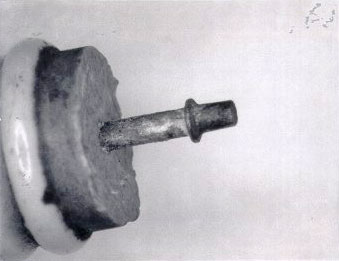
Figure 7
The top half of a 1920s Champion spark plug - minus the brass hat
It should be noted that the corrosion of the Coso Artifact almost
completely destroyed any of the iron-alloy-based components, with
the exception of the metal shaft encased in the porcelain cylinder.
The samples received from Chad Windham also revealed corrosion of
the iron-based components, but the brass top hats were unscathed,
with the exception of some tarnishing. If the Coso Artifact is
indeed a 1920s-era Champion spark plug, the X-ray of an almost
perfectly preserved top hat is exactly what one would expect. Brass,
a copper-zinc alloy is commonly engineered to resist corrosion far
better than iron-based alloys. In harsh environments, copper tends
to outlast iron, but still succumbs fairly quickly. The rates of
decay in the Coso Artifact match the rates of decay one would see in
a 1920ís era Champion spark plug.
For an excellent review of how ferrous
and non-ferrous alloys decay over time, please see "The Elements of
Archaeological Conservation" by J.M. Cronyn. This article includes
numerous photographs, including X-rays, of contemporary objects that
have completely decayed into oxide nodules. Like the Coso Artifact,
these examples also feature empty cavities where the original
materials once resided. Examples include X-rays of a nodule
containing the perfectly preserved shape of a bolt, plating on a
padlock (including its internal workings), and a belt buckle.
The formation of the iron oxide nodule likely was hastened by the
fact that corrosive "mineral dust" is blown off of the dry lake bed
of Lake Owen and onto the surrounding uplands where the artifact was
discovered. Salts created by the evaporation of the lake water is
regularly blown off of the lake bed by local windstorms. The U.S.
Geological Survey has conducted extensive investigations of this
phenomena.
(Source
http://geochange.er.usgs.gov/sw/impacts/geology/owens/
May 31, 2000)
Finally, as noted earlier, the last known individual in possession
of the artifact was Wallace Lane, who was offering it for sale for
$25,000. Bill Bond, a spark plug museum curator was asked how much a
1920s-era Champion spark plug would be worth today. His answer was,
"A couple oí bucks. Max."
Reaction
from the Paranormal Community
During the course of research, the authors of this paper asked Dr. Chittick why he felt
the Coso Artifact was an object worthy of
presentation to the public. Dr. Chittick was specifically asked how
he reconciled a previous age estimate of 500,000 years with his
young-earth creationist beliefs. On September 29, 1999 Chittick
responded:
The articleís speculation that it
had taken at least 500,000 years to attain the present form is
just that: speculation. Actual petrification of such objects
proceeds normally quite rapidly, as is illustrated by several
other similar formations. See for instance, the note about the
petrified minerís hat on the back cover of Creation Ex Nihilo
(Vol. 17, No. 3) for June-August, 1995. See also an article
about another "fossil" spark plug in Creation Ex Nihilo (Vol.
21, No. 4) for September-November, 1999 on page 6.
You asked what I thought about its age. My best guess is that it
is probably early post-Flood. I have not yet been able to obtain
sufficient documentation, so I donít say much publicly. However,
there is evidence that they did in fact perhaps have internal
combustion engines or even jet engines way back then.
Dr. Chittickís revelation that he was
already aware of "fossil" spark plugs was startling. Dr. Chittick
was asked in a follow-up letter about how he can positively date the
Coso Artifact to the Great Flood since he was already aware of
contemporary spark plugs that appear to be fossilized. In his
response on October 23, 1999, he commented:
It has not been my privilege to
personally examine the Coso artifact or location and strata
where it was found. There are two reasons I considered the
artifact significant.
1. It obviously is a man-made item.
2. Those who evaluated the strata said that it appeared
to be old, not modern strata. Those two items are the principle
basis for my conclusion that it was worth study. Certainly it
does merit further study in my judgment. Numerous items like
that abound, but I havenít been able to document them as
thoroughly as I would like, and so I donít say too much about
them.
As noted earlier, the alleged strata
where the Coso Artifact was found is unknown since all three
discoverers had separately searched for geodes all morning before
consolidating their collections in a single sack. Even if the exact
location was discovered, the artifact was an oxide nodule freely
laying on the surface, so the strata where the item was discovered
is irrelevant.
Once the investigation revealed beyond a reasonable doubt the true
origins of the artifact, Dr. Chittick was informed by Pierre
Stromberg via postal mail. Dr. Chittick was warned about the
publication of this paper, and was urged to issue a preemptive
retraction as well as paste a disclaimer in his book detailing the Coso Artifact story as fallacious. Dr.
Chittick never responded but
as of July 17th, 2004, no longer mentions the Coso Artifact in his
public lectures. However, the second edition of "The Puzzle of
Ancient Man" continues to promote the spark plug controversy on page
7, chapter1 with no disclaimer. Dr. Chittick has recently noted that
he is working on a revision of the book.
Ken Clark of Spokaneís Creation Outreach at first expressed interest
in the new discoveries. But when he learned that the true identity
was a 1920s-era Champion spark plug and was offered detailed proof,
he no longer communicated with the authors of this article. As of
July 17th, 2004, Creation Outreach continues to promote
the Coso
Artifact but notes that,
"Several readers have stated that
this artifact is indeed a spark plug from the 1920ís."
Conclusion

Figure 8
A Ford Model T. 1920s Champion spark plugs were widely used in this
vehicle.
The Coso Artifact is a remarkable example of how creation "science"
fails when the assumptions of its theory are implemented in a real
life archaeological situation. Young-earth creationists commonly
assume that almost all sedimentary layers were deposited during the
Great Flood. Therefore, any items closely associated with such
strata must date back to the time of Noah.
Perhaps the most surprising revelation is the stunningly poor
research Dr. Chittick conducted regarding the artifact. Several
times he referenced creationist articles that should have cast the
original claims in extreme doubt. But somehow, he continued to be
fascinated by the artifact. Anti-creationists familiar with Dr.
Chittick will remember a previous incident with Dr. Chittick. When
confronted about his fallacious statements by Jim Lippard regarding
Lucyís knee joint in the mid 1990s, he ignored these warnings and
continued to mislead his audiences until confronted in person by
Pierre Stromberg at the conclusion of a lecture in Seattle.
The Coso Artifact was indeed a remarkable device. It was a 1920s-era
Champion spark plug that likely powered a Ford Model T or Model A
engine, modified to possibly serve mining operations in the Coso
mountain range of California. To suggest that it was a device
belonging to an advanced ancient civilization of the past could be
interpreted as true, but is an exaggeration of several thousand
years.
Acknowledgments
This paper would not have been possible without the gracious help
from the following individuals:
-
Chad Windham
-
Bill Bond
-
Mike Healy
-
Jeff Bartheld
-
Arnie Voigt
-
Dr. David Q. King
-
Ken Atkins
-
Gary L. Bennett
-
Dr. Alan Bowes
-
Linda Safarli
-
Casey Doyle
-
Paul Cook
-
Ross Langerak
References
-
Willis, Ronald J. 1969 (Spring).
The Coso Artifact. The INFO Journal 1(4): 4-13.
-
Cook, Joe. 1998 (Summer). Where
Did You Get That? The Igniter 23(3): 20.
-
Steiger, Brad. 1974. Mysteries
of Time and Space. Prentice-Hall, New Jersey.
-
Anonymous. 1998 (March-May).
Bell-ieve It: Rapid rock formation rings true. Creation
20(2): 6.
-
Anonymous. 1991
(December-February). Fossil pliers show rock doesnít need
millions of years to form! Creation 14(1): 20
-
Anonymous. 1998 (June-August).
Fascinating Fossil Fence-Wire. Creation 20(3)
-
Noorbergen, Rene. 1977. Secrets
of the Lost Races. Bobs-Merrill Company.
-
Steiger, Brad. 1979 (March 4).
Were Ancient Scientists Really Tuned to Today? Parade. 9-10
-
Cronyn, J. M. 1990. The Elements
of Archaeological Conservation. Routledge, London.
-
Anonymous. 1999
(September-November). Sparking interest in rapid rocks. A
íspark-plug fossilí has lessons for long-agers. Creation
21(4). 6.
-
Chittick, Donald E. 1997. The
Puzzle of Ancient Man. Precision Graphics, Oregon.
|








